On Thursday, I gave a talk to the Kootenay History Interest Group. These folk take delight in exploring a wide range of local history: artifacts, buildings, characters. It struck me that historical language might be grist for this mill.
Language changes. There is perhaps no period in history when the curmudgeons of the world did not decry shifts in language: the way younger folks have changed the meaning of earlier words and have blurred distinctions formally recognized.
Being a curmudgeon myself, I have great sympathy with the these concerns. Why, I wonder, does no one still recognize the difference between the words: simple and simplistic, nauseated and nauseous, restless and restive, uninterested and disinterested, historical and historic, unusual and unique? Now when I hear someone use any of the second words—simplistic, nauseous, restive, disinterested, historic, unique—I just assume that that person means something other than what was said.
So, it goes. In such matters, the curmudgeon will always lose; time is not on his side. Language changes; meanings change. For those who like history, nuance, and continuity, the only thing left to do is to write the obituaries of a few dying terms.
Yet, many of these shifting usages could describe language anywhere in the English-speaking world. My immediate interest is the shift in commonly used local language.
A major shift has resulted from our changing relationship with one of our central geographic features: Kootenay Lake. There was a time when moving people and goods over this rugged land was arduous and slow. Over water was the easy way, so whether by rowboat or sternwheeler, Kootenay Lake provided the pathway. When railways were built, people and goods adopted the train. They changed again with the construction of extensive roads and bridges. Changes in transportation resulted in changes in language.
A second language shift in common local usage reflects changing local industries such as logging and agriculture. Of course, agriculture has never been big around here, but the substantial number of residual fruit trees speaks to many earlier attempts to make a living from orchards (it might be argued that the primary local crop is now the sub rosa production of Cannabis sativa indica).
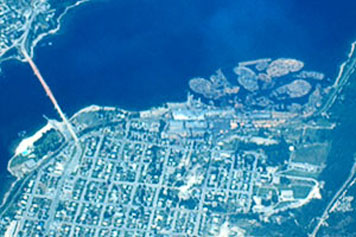
Log booms lie along Nelson's waterfront in this 1973 areal view.
Here are a few examples of words that are generally no longer recognized by the local public:
Booms: The term for a large collection of logs on water which could be pulled by tug to a mill. Log booms vanished from Kootenay Lake when Kootenay Forest Products closed in 1982. Logs are now moved by truck along the roads.
Camp: In the days before the bridge (1957) the West Arm of the Lake was maybe 90% seasonal dwellings. The term for such family summer properties was a camp. Wikipedia now claims that a camp (as a noun) refers to a group retreat. We have and have had a few of these around here: Camp Koolaree, Camp Lourdes (both religious), Camp Busk (scouting), and now Tipi Camp (yoga). But, families who repair to their rustic structures by the lakeside no longer seem to go to their camps. Now the North Shore is 90% permanent residences. I note that the upscale, year-round Yasodhara Ashram styles itself a study centre.
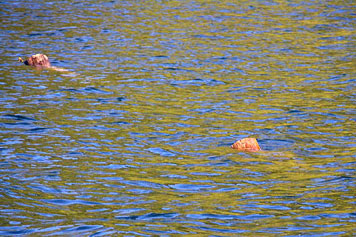
Deadheads, semi-submerged logs, were a hazard to boats.
Deadhead: My dictionary tells me that it now means a follower of the rock group, Grateful Dead. But, when I worked for the C.P.R. it was an empty trip: no paying passengers or freight. It is still used as trade jargon among those who transport things. However, in the days of log booms, it was a partially submerged log—invariably, one that had escaped from a boom. Deadheads were significant hazards to boats. They were once common; indeed, there are still a couple of places that have them along the West Arm, but generally this term from the days of log booms has vanished from local language. The loss of the deadheads themselves is not to be regretted.
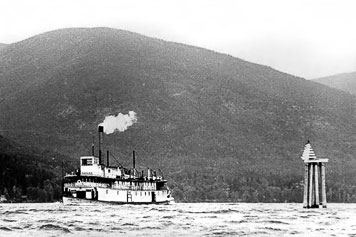
When the Lake served as the primary transportion route, dolphins were familiar markers. Picture taken in 1952 by Denis Daly.
Dolphin: To me, the symbol of the Lake is the dolphin. These are the navigational beacons that allowed the sternwheelers to avoid the sand points; they still serve local boat traffic. The term is old, and although it refers to any bound group of pilings, it is used locally to apply to one used for navigation. The terminology, dolphin, is not only officially correct (thank you, Canadian Coast Guard), but it was the universally used term of my youth. Now, I hear Nelsonites refer to these structures as buoys. They pronounce it: bOO-EE. That is the American pronunciation of a device Canadians pronounce as BOY. A buoy is called a BOY because it is BOYant. However, calling it either of these—a BOO-EE or a BOY—is idiotic because a dolphin is not buoyant: it is embedded in the lake bottom. So, what happened to the word, dolphin? Even modern pleasure boaters seem to have lost the term.
Froe: In the days before metal roofs, shakes were used. The tool used for splitting shakes is a froe.

Early lakeshore homes were built with the front facing the Lake. Now, such homes place the grand entrance facing the road.
Front of the house: Here is the rule, if you live along the lakeshore, the front of the house faces the water. That is how lakeside homes are designed—or at least that is how they used to be designed. This used to make sense: you wanted your house to face the water, and every visitor came by boat. Not only the front of the house faced the Lake, but the front door faced the Lake. Then people began to travel by road. We now have the bizarre state of affairs where the front of the house faces the Lake, but the front door faces the road. So, the front door is on the back of the house.
Highball: This is a logging term that meant: hurry up the project.

Landings linked transportation and settlers. R.T.Fraser took this of the SS Nasookin at Fraser's Landing in 1935.
Landing: When the means of getting around the region was by water, the Landings were the portals to farms, orchards and homes. Dozens of them were marked on the map. A few survive in such legacies as Macdonald’s Landing and Johnston’s Landing. These are the places that served everything from sternwheelers to rowboats. Now, the term, landing, has degenerated into realtor schlock (e.g., Kutenai Landing).
Layritz: Layritz Nurseries in Victoria supplied most of the fruit trees used locally. He also introduced rhododendrons to BC, of which a local grove still survives. At one time the name Layritz was better known locally than the name of the Prime Minister.

Only the animals now know where all the fruit trees from Layritz are to be found.
Local names: It is to be expected that many local names will be lost both as a result of shifting modes of transportation and the filling in of the gaps between named settlements. Some that have drifted out of local consciousness are: Outlet, Cedar Point, Ferguson’s Point, and of course, many landings such as Gibson’s and Fraser’s.
Milk run: When used today, this term seems to mean merely an uneventful trip. But, originally, it was a trip with frequent stops to to pick up each farm’s daily milk output. In the West, that was often done by train. Apparently, it no longer means this: the term now has lost the meaning of a trip with endless stops. It is the opposite of the one meaning of deadhead.
Narrows: Formed by creek deltas, the narrows are constrictions to the flow of water along the West Arm of Kootenay Lake. The narrows are navigation bottlenecks, they alter the waves, they produce an overturning of the water and so alter the surface temperature of the water for swimming, and they bring fish to the surface. Each of the narrows along the arm has a name: Fraser, Harrop, Kokanee, Nine-mile, and Six-mile (and all have dolphins). These were markers on any trip along the Lake. Now, even the general term, narrows, has largely vanished from everything but the navigation charts.
Peavey: This is a long handled tool used for rolling or moving a log. To the handle was attached a heavy steel point and a hinged steel hook.
Pilings: The Lake is festooned with pilings. These are the heavy beams driven vertically into the Lake’s bottom usually to secure a dock or float. More often than not, when I hear someone in Nelson refer to them now, they are at a loss for an appropriate word and merely call them a post—as if they were equivalent to a fence post. One suspects that these people would think that a pile driver was probably a device to treat hemorrhoids.
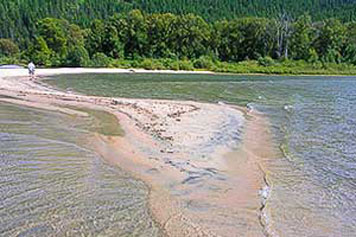
Sand points of the West Arm extend at right angles to the shore.
Points: These are an unusual feature of the western half of the West Arm—points of sand extending at right angles to the shore. They are named after the distance along the Lake from the Nelson’s Pier (at the foot of Hall Street): Five-mile Point, Seven-mile Point. I sometimes hear a person these days fish for terminology and call them sand spits. Indeed, there is a sand spit on the arm at Kokanee Park. But the sand spits (which lie parallel to the shore) are not sand points (which extend at right angles).
Punkwood: These are little pieces of driftwood that strutting children would light and smoke in imitation of their elders’ cigaretts. The repulsive taste may have done more to discourage smoking than all the ads.
Rafting dogs: This is a term from the days when logs travelled down the Lake in booms. This era ended in 1982 when Kootenay Forest Products closed its mill in Nelson. The rafting dogs comprised a metal spike topped with a ring. The spike was driven into a log and ring enabled many logs to be chained together to form the perimeter of a boom or a group of salvaged logs to be joined.
Rural Route: When I was a child on the North Shore, our postal address was: R.R. #1, Nelson. The designation, Rural Route, has now vanished, although I still think of myself as rural. The term, rural route is still used within the postoffice by the mail sorters and carriers, but it is now trade jargon, not part of the public’s language. From the point of view of Canada Post, I live in Nelson; Telus tells me that I live in the never-never land of North Nelson; the BC Government wins with the beautifully crafted term, Area F.
Shook: The bundles of parts that had to be assembled to make an apple or cherry box. These were assembled with 1 ½ inch box nails.
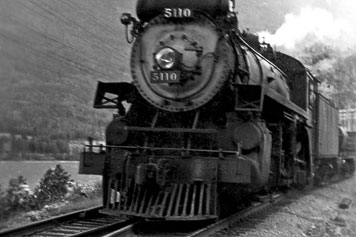
One did not turn a key and drive off; one had to get the steam up. A 1949 picture of a steam engine at Troup by Denis Daly.
Steam up: Steam once powered sternwheelers, tugs and railway engines, but no more. Before the train could pull out from the station, or the ship from the dock, the pressure in the boiler had be quite high—one needed to get the steam up.
Tin tops: The local meaning of this arose in cherry orchards. These are the baskets into which cherries were placed as they were being picked. They were made of thin wood held together by tin bent over the top. Nowadays, a tin top is used by classic car collectors to describe a coupe as opposed to a convertible.
Finally we come to the biggie and the saddest loss of all: the West Kootenay.

Gulp, who dreamed up this abomination?
West Kootenay: The West Kootenay was formed when the Kootenay district was split into East and West portions in 1888. This is a fairly simple idea: there is a West Kootenay and an East Kootenay; taken together they are often referred to as the Kootenays. So far, so good. After the division, reports and books began to refer to the two districts together as the East and West Kootenays. This practice seems to have lasted though the Second World War. But, in the 1950s, writers began to use the same cadence when referring to the western district alone. Some called the district the West Kootenays—a bit of linguistic ineptitude that implied that there were multiple West Kootenays. Now, it seems that the default option is to say: the West Kootenays. Sigh, this usage is unmitigated nonsense.
So, it goes: Words come and go; Language changes and a history interest group might well choose to watch the change in local language in the same way it watches the parade of historical characters and buildings.
I am indebted to Tom Lymbery, Ron Welwood, Kevin Underwood and Don Lyon who suggested some words to include here.

Hi Alistair. I really liked the vocabulary lesson. I learned some new words and terms. The one area I am not in complete agreement with is the front/back of the house. I still believe that people right on the lakeshore call the front of the house the side that faces the lake – at least that’s what we do on RedFish Road …
Ian, yes, lakeside residents still think of the front of the house as being the one facing the water. Yet, modern homes have a design that places the grand facade and its front door facing the road, not the water. Urban, cookie-cutter designs are incongruously dumped on the shore of the Lake.
This is a reversion. When we moved to Quebec in the early 70’s it was quite noticeable that homes were build with the decks facing the road. A more social arrangement with people sitting in the evenings facing each other. The more western fashion of decks facing the view or away from the neighbours was encroaching when I moved west in the early 80’s. Now I see the eastern abominations moving west.
As for the log booms, one of the first impressions of this area when I visited in 1981 was from the flight to Castlegar. The mountaintops were cleared and the log booms on the lake.
Interesting vocabulary lesson, Alistair. For that, I thank you.
It is also interesting that you think the majority of society (myself included) are a bunch of ignorant idiots… something I’m sure your elders thought of you and your generation, when you were younger. I guess some things in history don’t change.
Geoff, my posting wasn’t a vocabulary lesson, it was a memorializing of the old words (and it was offered to history buffs).
It is also unclear to me why you chose to suggest derogatory thinking on my part. I was writing about how words change and I neither implied nor thought anything good or bad about the character of the people making the changes. Why would you think this chronicle of shifting usage amounted to a criticism of anyone? Indeed, I suggested that the changes arose quite reasonably because of changing patterns of transportation or agriculture.
There was of course, one exception to this where I did decry the shift: the use of the term, West Kootenays. I do consider it sloppy to have transferred this singular region into multiple ones. Do we speak of the North Okanagans or the West Cariboos? My maps show only one West Kootenay.
Highball: I understand that this term originated in railroading and refers to the practice of hoisting a metal ball to the top of a pole as a signal to a locomotive engineer to proceed at full speed.
Rafting dogs: When I was a kid in the 60s we did a lot of boating on Okanagan Lake. My dad always kept a dog in the boat so we could moor to a log boom. It had a wedge-shaped spike and functioned like a climbers’ piton. A sideways blow from the hammer readily dislodged it.
West Kootenays: I believe this term owes much of its currency to analogy with the way mountain ranges are named: the Rockies, the Selkirks, the Purcells, etc.
Cannabis sativa: A guy I know says most of the dope grown in the Kootenays is C. indica rather than sativa. Hybrid strains are also cultivated, but very little C. sativa as such. So the guy says. Me, I wouldn’t know.
Bob, This origin for highball is new to me; That is a nice story about rafting dogs; I will take your word on sativa and amend the text. Now, about West Kootenays, I have heard before that the plural owes something to an analogy with mountain ranges. But, that is an ex post facto argument—an attempt to justify a mistake whose origin was quite different. I discuss the history of the plural in a blog posting entitled Plural ascending and then treat the issue again in Promoter incompetence. What is becoming clear is that this illogical construction is gaining currency and that the singular is losing ground.
Punkwood: This was a rare commodity. More common though less satisfying for childhood cigarettes were dry milkweed stems. They burned fast but would supply a few mouthfuls of smoke. If puffed too hard they supplied a mouthful of flame. “Punks” however were the joss sticks sold for a few cents each in the week-long firecracker season leading up to Hallowe’en. They were used to set fire to the crackers’ fuses. Tiny firecrackers were called “ladyfingers”. You could actually hold them between your fingertips as they exploded. Great big firecrackers were called “cannon-busters”. They were ideal for serious demolition projects such as those directed against ant heaps and mail boxes. They were expensive and dangerous, the danger justifying the expense.
Bob, punkwood wasn’t rare if you spent the summer months at the beach (as did I and did Kevin, the person who suggested the term). It just drifted in. The rarer commodity was the match to light it. About firecrackers, I defer to your insights.
As a youth in Vancouver, I seem to remember “cherry bombs” describing the extra big fire cracker.
Hi Alistair, the bulk of the words you put forward have roots (ha ha) in logging parlance, and are very much in use to this day. If the terms seem to be disappearing from common use, it may be because loggers as a sub-culture are disappearing!
Interestingly, there is a lot of cross-over between logging and tree-planting vocabulary, and this may have kept some of these terms in common use (at least in the Kootenays, where almost everyone I know spent their youth planting trees).